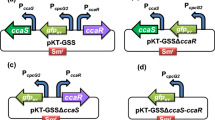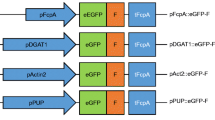Abstract
Extracellular alginate lyase (alyA) has an important role in the use of alginate in the marine bacterial strain Pseudoalteromonas atlantica AR06. Green fluorescent protein (GFP) is a convenient, useful tool for visualization of gene expression, and here we introduced the gfp gene at the end of alyA by homologous recombination in AR06. The gfp gene was expressed as a polycistronic transcript in reporter strain ARAG (AR06 alyA-gfp). The analysis of GFP fluorescence of ARAG in minimal medium containing a carbon source (sucrose, mannitol, glucose, or glucuronate) revealed that the alyA was induced by alginate and regulated by carbon catabolite repression by the coexistence of each carbon substrate (sucrose, mannitol, and glucose). The transcription start site of alyA was identified 192 bp upstream from translation start site of alyA and the 10-bp sequence was a palindrome in which the transcription start site [G] was at the end. Thirteen kinds of plasmids were constructed for promoter analysis of alyA, which contains between 215 and 618 bp of upstream sequence from the translation start and gfp. Longer sequences than 339 bp were capable to increase the GFP fluorescence responding to alginate in the homologous recombination alyA deletion mutant strain ARAΔ (AR06 ΔalyA). The 339-bp upstream sequence was proved sufficiency for reproduction of the catabolite repression of alyA. These results indicate that (a) transcription of alyA is probably regulated by substrate recognition systems driven by multiple factors and (b) regulation of alyA requires a cis element on the upstream region of alyA.







Similar content being viewed by others
References
Bodenmiller DM, Spiro S (2006) The yjeB (nsrR) gene of Escherichia coli encodes a nitric oxide-sensitive transcriptional regulator. J Bacteriol 188(3):874–881
Boyer HW, Roulland-Dussoix D (1969) A complementation analysis of the restriction and modification of DNA in Escherichia coli. J Mol Biol 41:459–472
Dheilly A, Soum-Soutéra E, Klein GL, Bazire A, Compère C, Haras D, Dufour A (2010) Antibiofilm activity of the marine bacterium Pseudoalteromonas sp. strain 3 J6. Appl Environ Microbiol 76(11):3452–3461
Duilio A, Tutino ML, Marino G (2004) Recombinant protein production in Antarctic Gram-negative bacteria. Methods Mol Biol 267:225–237
Figurski DH, Helinski DR (1979) Replication of an origin-containing derivative of plasmid RK2 dependent on a plasmid function provided in trans. Proc Natl Acad Sci USA 76(4):1648–1652
Hashimoto W, He J, Wada Y, Nankai H, Mikami B, Murta K (2005) Proteomics-based identification of outer-membrane proteins responsible for import of macromolecules in Sphingomonas sp. A1: alginate-binding flagellin on the cell surface. Biochemistry 44(42):13783–13794
Haug A, Larsen B, Smidsrød O (1966) A study of the constitution of alginic acid by partial acid hydrolysis. Acta Chem Scand 20:183–190
Hoang TT, Karkhoff-Schweizer RR, Kutchma AJ, Schweizer HP (1998) A broad-host-range Flp-FRT recombination system for site-specific excision of chromosomally-located DNA sequences: application for isolation of unmarked Pseudomonas aeruginosa mutants. Gene 212(1):77–86
Iwamoto Y, Iriyama K, Osatomi K, Oda T, Muramatsu T (2002) Primary structure and chemical modification of some amino acid residues of bifunctional alginate lyase from a marine bacterium Pseudoalteromonas sp. strain no. 272. J Protein Chem 21:455–463
Kovach ME, Phillips RW, Elzer PH, Roop RM 2nd, Peterson KM (1994) pBBR1MCS: a broad-host-range cloning vector. Biotechniques 16:800–802
Martin C, Steven RK (2005) Methods of biochemical analysis, green fluorescent protein: Properties, applications and protocols, Volume 47, 2nd. Wiley-Liss
Matsushima R, Danno H, Uchida M, Ishihara K, Suzuki T, Kaneniwa M, Ohtsubo Y, Nagata Y, Tsuda M (2010) Analysis of extracellular alginate lyase and its gene from a marine bacterial strain, Pseudoalteromonas atlantica AR06. Appl Microbiol Biotechnol 86(2):567–576
Mekjian KR, Bryan EM, Beall BW, Moran CP Jr (1999) Regulation of hexuronate utilization in Bacillus subtilis. J Bacteriol 181(2):426–433
Murata K, Inose T, Hisano T, Abe S, Yonemoto Y, Yamashita T, Takagi M, Sakaguchi K, Kimura A, Imanaka T (1993) Bacterial alginate lyase: enzymology, genetics and application. J Ferment Bioeng 76:427–437
Onsøyen E (1996) Commercial applications of alginates. Carbohydr Europe 14:26–31
Rosochacki SJ, Matejczyk M (2002) Green fluorescent protein as a molecular marker in microbiology. Acta Microbiol Pol 51(3):205–216
Ruvkun GB, Ausubel FM (1981) A general method for site-directed mutagenesis in prokaryotes. Nature 289:85–88
Sambrook J, Fritsch EF, Maniatis T (1989) Molecular cloning: A laboratory manual, 2nd edn. Cold Spring Harbor Laboratory Press, Cold Spring Harbor
Sawabe T, Takahashi H, Ezura Y, Gacesa P (2001) Cloning, sequence analysis and expression of Pseudoalteromonas elyakovii IAM 14594 gene (alyPEEC) encoding the extracellular alginate lyase. Carbohydr Res 335:11–21
Sawabe T, Fukui Y, Stabb EV (2006) Simple conjugation and outgrowth procedures for tagging vibrios with GFP, and factors affecting the stable expression of the gfp tag. Lett Appl Microbiol 43(5):514–522
Stretton S, Techkarnjanaruk S, McLennan AM, Goodman AE (1998) Use of green fluorescent protein to tag and investigate gene expression in marine bacteria. Appl Environ Microbiol 64(7):2554–2559
Sutherland IW (1995) Polysaccharide lyases. FEMS Microbiol Rev 16:323–347
Uchida M (1995) Enzyme activities of marine bacteria involved in Laminaria-thallus decomposition and the resulting sugar release. Mar Biol 123:639–644
Uchida M, Nakayama A (1993) Isolation of Laminaria-frond decomposing bacteria from japanese costal waters. Nippon Suisan Gakkaishi 59:1865–1871
Uchida M, Maeda T, Shiba T (2002) Phylogenic analysis of three marine bacteria that have an ability to decompose Laminaria japonica. Fish Sci 68:703–705
Wong TY, Preston LA, Schiller NL (2000) Alginate lyase: review of major sources and enzyme characteristics, structure-function analysis, biological roles, and applications. Annu Rev Microbiol 54:289–340
Acknowledgments
This work was supported by a Grant-in-Aid from the Ministry of Agriculture, Forestry, and Fisheries, Japan.
Author information
Authors and Affiliations
Corresponding author
Electronic Supplementary Material
Below is the link to the electronic supplementary material.
ESM 1
(DOC 42 kb)
Fig. S1
Paph and Plac indicate ahp promoter and lac promoter, respectively. oriV, oriT, and sacB indicate origin of replication, origin of conjugal transfer, and levansucrase, respectively. TT and MCS represent transcription terminator and multiple cloning site, respectively. Pentagons indicate orientations of ORFs. (EPS 1109 kb)
Fig. S2
Measurement of fluorescence from each strains of ARAΔ(pBBR215G to pBBR319). Values of measurement of GFP fluorescence divided by OD were plotted. Each value was acquired from ARAΔ derivatives cultured in ASW medium containing 0.3 % of alginate—triangles and sucrose—asterisks, respectively. The values with their standard deviations were obtained from triplicate measured value. The 0 time values represent non-inducible GFP fluorescence in the MB liquid medium. a–f Measured values of the ARAΔ derivatives which introduced pBBR215G to pBBR319G, respectively. (EPS 1114 kb)
ESM 4
(DOC 197 kb)
Rights and permissions
About this article
Cite this article
Matsushima, R., Watanabe, R., Tsuda, M. et al. Analysis of Extracellular Alginate Lyase (alyA) Expression and its Regulatory Region in a Marine Bacterial Strain, Pseudoalteromonas atlantica AR06, Using a gfp Gene Reporter System. Mar Biotechnol 15, 349–356 (2013). https://doi.org/10.1007/s10126-012-9488-6
Received:
Accepted:
Published:
Issue Date:
DOI: https://doi.org/10.1007/s10126-012-9488-6




